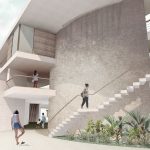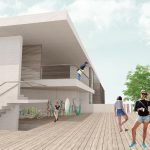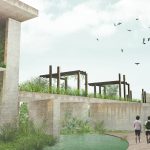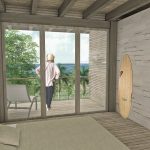Hotel club para surfistas: arquitectura registro del tiempo y el lugar
” El envejecimiento como fenómeno natural, trae consigo transformaciones que demuestran la condición finita de todo lo que existe en el tiempo y espacio. En arquitectura, es un componente activo del proceso de diseño, capaz de transformar, destruir y construir espacios y atmósferas. – Elisabet Sifonte Rodriguez “
Designer: Elisabet Sifonte Rodriguez
Thesis date: January 2016
Thesis director and Committee: Arq.José Coleman-Davis; Arq.Victor Nieto Villalón;
Asesor de idioma: Tamara E. Perez Hernández.
TOS[er]: Mercedes Múzquiz Ferrer
TOS post: May 2016
Como una oportunidad para acercarse a la idea de una arquitectura más humana y sensible, Elisabet Sifonte estudiar el proceso de envejecimiento de la misma. Las alteraciones físicas de una estructura son producto de factores como tiempo y la realidad climatológica del lugar en que se ubican. Estos pueden reinterpretarse como capas de información que registran las condiciones espacio-temporales de un lugar. La estrategia de diseño del hotel-club para surfistas reconoce el paso del tiempo en el lugar y sirve como parámetro de diseño que delimita el proyecto en términos formales, espaciales, recorridos programáticos y tectónicos-materiales. Tiene lugar en el área de la playa La Ocho y del Balneario Escambrón, está dirigido al surf y a actividades relacionadas con el deporte, con un programa completo de habitaciones, gimnasio, spa, mirador, piscina y áreas de estar. En este contexto, la propuesta establece relación visual y formal con la antigua Segunda Línea de Defensa de la muralla y se inspira con el lenguaje curvilíneo de los hitos naturales del lugar (el árbol Flamboyán y Ficus). A través de esta investigación, Elisabet busca ofrecer nuevas oportunidades de cómo entender y gestionar el proceso de marchitación dentro del campo de arquitectura y reutilizar sus recursos.
As an opportunity to approach the idea of a more humane and sensible architecture, Elisabet Sifonte studies the aging process. Climatological conditions cause most physical alterations to structures. These can be reinterpreted as layers of information that record the spatio-temporal conditions of a place. The design strategy for the surfers hotel club recognizes the passage of time in the place. It serves as a parameter that defines the project in formal, spatial, programmatic and tectonic terms. It takes place close to the Ocho and Escambrón beaches that are attractive for surfing and other sport- related activities with a full program such as rooms, gym, spa, pool and passive recreational areas activities. The building aims to tie in memories of the past with the existing context through the use of wooden and concrete detailing and by establishing exterior-interior relationships. The proposal provides visual and formal relationships with the former Second Line of Defense of the historical fortification walls and is inspired by the curvilinear language of natural landmarks of the place such as the local Flamboyan and Ficus trees. Through this research, Elisabet aims to provide new opportunities for how to understand and manage the process of wilting in the field of architecture and how to reuse its resources.







